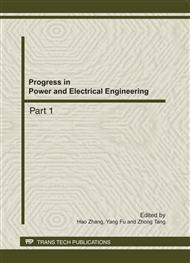[1]
Wang RZ. Adsorption refrigeration research in Shanghai Jiao Tong University. Renewable and Sustainable Energy Review 2001;5(1):1–37.
DOI: 10.1016/s1364-0321(00)00009-5
Google Scholar
[2]
Sakoda A, Suzuki M. Fundamental study on solar powered adsorption cooling system. J Chem Enging Jpn 1984;17(1):52–57.
Google Scholar
[3]
Cho SH, Kim JN. Modeling of a silica gel/water adsorption cooling systems. Energy 1992;17(9):829–839.
DOI: 10.1016/0360-5442(92)90101-5
Google Scholar
[4]
Saha BB, Boelman EC, Kashiwagi T. Computer simulation of a silica gel-water adsorption refrigeration cycle – the influence of operating conditions on cooling output and COP. ASHRAE Trans Res 1995;101(2):348–357.
Google Scholar
[5]
Boelman EC, Saha BB, Kashiwagi T. Parametric study of a silica gel-water adsorption refrigeration cycle – the influence of thermal capacitance and heat exchanger UA-values on cooling capacity, power density and COP. ASHRAE Trans1997;103(1):139–148.
Google Scholar
[6]
Yonezawa Y, Matsushita M, Oku K, Nakano H, Okumura S, Yoshihara M, Sakai A, Morikawa A. Adsorption refrigeration system. US patent no. 4881376, 1989.
Google Scholar
[7]
Solar/waste heat driven two-stage adsorption chiller: the prototype. B.B. Saha, A. Akisawa, T. Kashiwagi. Renewable Energy 2001; 23:93-101.
DOI: 10.1016/s0960-1481(00)00107-5
Google Scholar
[8]
Waste heat driven dual-mode, multi-stage, multi-adsorber regenerative adsorption system B.B. Saha, S. Koyama, T. Kashiwagi, A. Akisawab, K.C. Ngc, H.T. Chua. International Journal of Refrigeration 2003; 26: 749-757.
DOI: 10.1016/s0140-7007(03)00074-4
Google Scholar
[9]
H. Yanagi. Development of adsorption refrigerator using a direct contact condensation and evaporation on sprayed water. Proceedings of the International Sorption Heat Pump Conference, Germany 1999: 671-676.
Google Scholar
[10]
R.E. Critoph. Simulation of a continuous multiple-adsorber regenerative adsorption cycle. International Journal of Refrigeration 2001; 24:428-437.
DOI: 10.1016/s0140-7007(00)00026-8
Google Scholar
[11]
Y.L. Liu, R.Z. Wang, Z.Z. Xia, Experimental study on a continuous adsorption water chiller with novel design, International Journal of Refrigeration, 2005; 28(2): 218-230
DOI: 10.1016/j.ijrefrig.2004.09.004
Google Scholar
[12]
Y.L. Liu, R.Z. Wang, Z.Z. Xia, Experimental performance of a silica gel-water adsorption chiller, Applied Thermal Engineering, 2005;25(2-3): 359-375
DOI: 10.1016/j.applthermaleng.2004.06.012
Google Scholar
[13]
D.C. Wang, Z.Z. Xia., J.Y. Wu., R.Z. Wang., H. Zhai., W.D. Dou., Study of a novel silica gel –water adsorption chiller. Part I. Design and performance prediction, International Journal of Refrigeration, 2005;(28): 1073-1083
DOI: 10.1016/j.ijrefrig.2005.03.001
Google Scholar
[14]
Elisa C. Boelman. Computer simulation of a silica gel-water adsorption refrigeration cyle-The influence of operationg conditions of cooling output and COP. ASHARE Transactions 1995; 13(6): 348-355.
Google Scholar
[15]
J.Y. Wu, R.Z. Wang, Y.X. Xu. Dynamic simulation and experiments of a heat regenerative adsorption heat pump. Energy conversion and managemant, 2000; 41(11):1007-1018.
DOI: 10.1016/s0196-8904(99)00161-2
Google Scholar
[16]
Y.L. Liu., Study on a solar driving silica gel-water adsorption refrigeration system. Doctor Thesis, Shanghai Jiao Tong University, 2005.
Google Scholar


